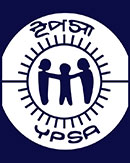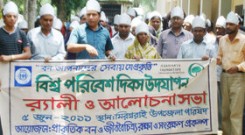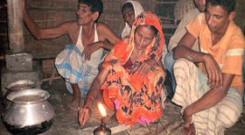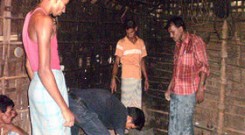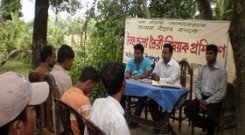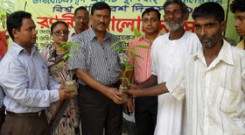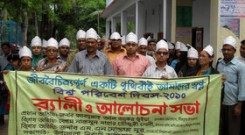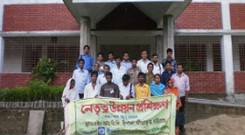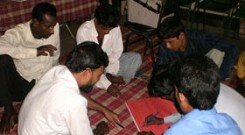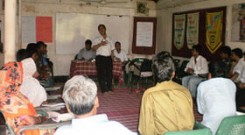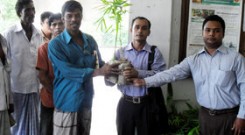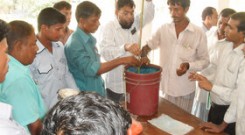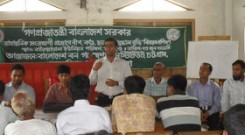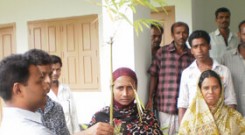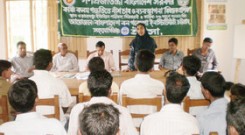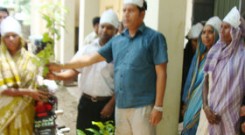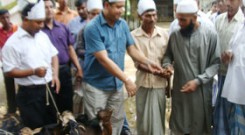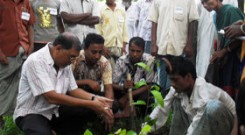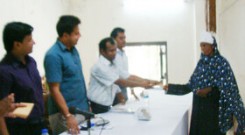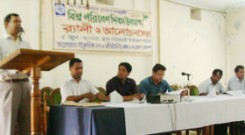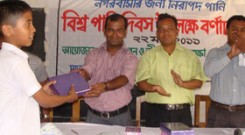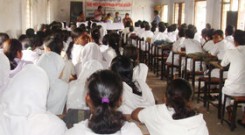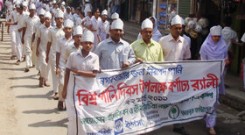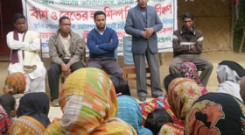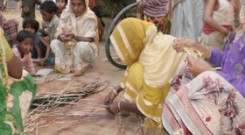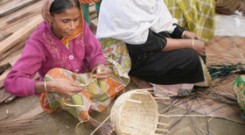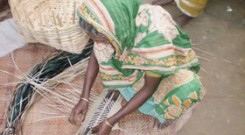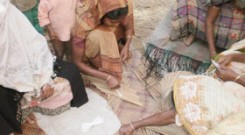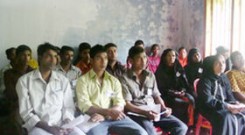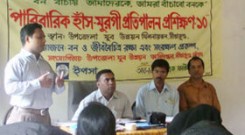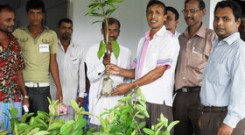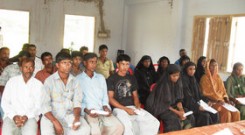Photo Gallery
Project title: Restoration and Conservation of biodiversity in the denuded hills in Sitakunda and Mirsharai, Chittagong
Introduction
Arannayk foundation has signed a MOU with YPSA for the Restoration and conservation of biodiversity in the denuded hills Sitakund & Mirsharai, Chittagong to establish co-management system involving forest department, forest users, local govt. & local leaders. YPSA has prepared this project document on the basis of field realities and focusing on the project objectives as well as goal. This project document has prepared with the concern of AF, which includes the specific/ indentified project area and location, implementing methodology, logical frame work, the roles and responsibility of project staffs and an estimated budget.
Background & Rationale
The vast hilly areas of Chittagong North Forest Division have been denuded for many years. Poor people of surrounding area collects fuel wood, leaf-litters, bamboos, broom grass and medicinal plants from the scrub forest.
The Forest Department (FD) has been implementing the GOB funded ‘Reforestation of Denuded Hills’ project since 2000-01. The project intervention includes establishment of plantations, involving both short and long-rotation species, under participatory afforestation scheme. The major species of trees that are planted are: Akashmoni, Mangium and Hybrid Acacia as short-rotation (10-12 yrs) species and Garjan, Chapalish, Sil koroi, Chikrashi, Dhaki jam, Telshur, and Boilam as long-rotation species. The benefit sharing arrangement of the project includes 45% of the final tree harvest (also of thinning) for the participants, 45% for the Forest
Department and 10% for Tree Fund. The participants are organized into 10-15 member sommittees. The participants plant country bean and ginger under the young plantation (1-2 years), but there is no other provision for promoting alternative income generating (AIG) activities among the participants.
With a target to cover 5,000 ha of the denuded hills in the Chittagong North Forest Division in its first phase, the above project achieved 70 – 80% of the target. The second phase of the project is expected to start in the current (2007-08) fiscal year for another 5 years. Even the prospective second phase of the above project would not cumulatively cover 50% of the total area of denuded hills in the Chittagong North Forest Division. Moreover, many of the plantations have failed to survive after their initial establishment (as long as the project had close monitoring) due to alleged destruction by people. People set fire in the forest for raising sun grass and to get fertilizer (of ashes) effect in their crop field below the hill. They also do not like the hills to grow into forest harboring wildlife that damage their crops and poultry birds. The fire also occurs from careless disposal of burning cigarette butts by the forest going people.
The experience, therefore, reveals that concerted efforts are needed in order to get the forest (and bio-diversity) back in the denuded hills, which should include peoples’ awareness raising, assisted natural regeneration or enrichment planting, creation of alternative livelihood opportunities for the forest dependent people, prevention of forest fire and making people proactive in protecting the forest.
In 2006, Arannayk Foundation has signed a MoU with FD for collaborating for the conservation and restoration of biodiversity assets of the tropical forests in Bangladesh. The MoU provides for establishing co-management system, involving FD, forest users’ groups and local leaders, for sustainable management of the remaining forests.
In May 2009, AF signed an agreement with YPSA for the implementation of this project with the following goal and objective
Goal and Objectives of the Project
Goal: The biodiversity (flora, fauna) of the Sitakunda-Mirsarai hills is restored and conserved by the stakeholders for sustainable environmental and economic benefits of the local communities
Objectives:
- Establishment of a collaborative management system (co-management) for a sizable forested area of Sitakunda-Mirsarai hills involving local communities, Forest Department (FD) and other stakeholders
- Restoration of tree cover and biodiversity and sustainable management of the forest
- Improvement of livelihood of the poor people living in and around the forests and their access to fuel wood through alternative means
- Creation of opportunities for revenue generation from forest recreation or eco-tourism based activities benefiting local community
Location and area
The proposed project would cover 200 ha area of denuded hills at the Baraiyadhala Beat (adjoining the village Madhya Wahedpur) of Baraiyadhala Range and another 200 ha of such land at the Gobinia Beat (along Mirsharai – Fatikchari Road) of the Mirsharai Range under Chittagong North Forest Division. The specific area under Bariadhala Beat is 5 villages of 2No Bariadala union and 4 villages of 15No Wahedpur union and 6 villages of 9 No Mirsharai union under Gobinia Beat, which have been selected/identified as direct working area of the project.
Baraiyadhala Beat comprises into two administrative upazila. Baraiyadhala union is under the Sitakund upazial and office set up of FD in this Upazilla and Wahedpur union is under Mirsarai Upazila but maximum forest area of this beat are in the Mirsharai upazilla. On the other side administrative area of Gobinia Beat is fully in the under Mirsharai upailla. The total forest area of Baraiyadhala Beat near about 1775.71 ha & total forest area of Gobinia Beat is 2753 ha. There are two forest block in Bariadala Beat one is Bariadala block and another is Wahedpur block. In the Gobinia Beat there are also two forest block one is Gobinia block and another is Ragunathpur block.
The boundary of Bariadala Beat is Nuna chara last border of south; Honai chara last border of North, Fatikchari and Hathazari upazilla located at the east site and Baraiyadhala and Wahadpur located at the west site. The boundary of Gobinia Beat is Kanir chara, last border of south and Mahama chara, last border of north, where Fatikchari upazilla located at east site and Mirsharai upazila located at the west site. The forest area will be identified/selected discussion with FD as soon as possible for implement the project activities.
Expected results & Planned Activities
The specific results expected against each objective of the project and the activities to be undertaken in order to achieve those results are presented in the attached Logical Framework (Annex-1).
Strategies/ Methodology
Criteria and process of selecting project participants
According to organizational mission of YPSA, it always works with the community, for the community and by the community. All types of work centered towards the community, so there is no doubt that without mobilizing the community people any development work is possible or sustainable. Keeping this mission in mind the entire population of the villagers surrounding the target areas will be mobilized for organizing a local movement on restoring and conserving the targeted forests.
All development activities of YPSA have been running on group based concept. Group will be formed comprising 15-20 forest dependant poor people. In the stockholder/ project participants’ selection process, YPSA will work collaborating with local Govt, local beat of forest department and local leaders of the villages (School teacher, Imam, other knowledgeable people) so that selection can be proper and perfect. For this reason, workshop/ community meeting, interview with forest users’, FGD in each union and villagers’ community under the region will be arranged/organized. The following issues will be considered during selection of project participants and group formation.
- Willingness of receiving different training
- Willingness of IGA/AIG
- Respect to sustainable agro-system, eco-tourism
- Willingness of protection and restoring the targeted forest and conservation of biodiversity.
Vision of institutional development of the project participants
One of the major objectives of the project is to establish a co-management system. In each village, a forest conservation committee shall be established in participatory manner. Moreover, in each village one or more groups (approximately 20) will be formed comprising 15-20 poor forest dependant people for promoting IGA activities. Forest conservation committee will be formed comprising 4-6 local leaders (UP member, teacher, Imam) of the villagers or group leaders in each village.
Effective protection and restoration of the each targeted forest area and its conservation of biodiversity, an apex body of the CBOs shall be formed on participatory approach by involving local Govt. officials, FD, local communities and local leaders etc. Co- management committee shall be established in each forest department range through the co-management council. Finally two CMC will be formed, where one is in Bariadala range and another one is Mirsarai range. 15 villages have been identified under 3 unions in the targeted forest area of both Baraiyadhala and Gobania beats. So, 15 forest conservation committees will be formed in 15 selected villages.
Human Institutional Development (HID) capacity of the CBOs shall be developed through training and accompaniment support. The CBOs will be supported to establish a revolving fund through group savings and by providing them with the seed money from the project. The CBOs shall assist to get appropriate Govt. registration.
Training approach
YPSA always encourage capacity building of human resources either it is for staff or stakeholder. Keeping this view in mind it has developed separate wing called training division under the human resource development department of YPSA. Training division organizes all types of training for internal & external people including the stakeholder of different project and conducted by the YPSA`s experienced resource pole members. Through this program YPSA will provide different need base AIG/IGA training (Entrepreneur Development Business Management training, enterprise development training, homestead gardening, handicraft, poultry and duck rearing, cow & goat rearing, beef fettering etc.) for capacity building of the project participants/ beneficiaries.
YPSA will also arrange some training (like development and association, sustainable agriculture and ecology, nursery development, forest & biodiversity conservation and its importance etc) collaborating with FD and relevant govt. and non govt. line agencies. As an NGO one of the main tasks of YPSA is to motivate different stakeholder and project participants through different CBOs meeting towards their positive changes.
Restoration of forest cover and biodiversity
The proposed project area have been denuded for many years, poor people of surrounding area collects fuel wood, leaf, litters, bamboos, broom grass and medicinal plants from the scrub forest. YPSA realize that there is urgent need for forest and biodiversity conservation through establishing co- management system involving FD, local govt. officials, forest users, community leaders. The following activities/ initiative will be carried out jointly by the FD, the CMC and forest users for the effective protection & restoration of the forest and conservation of biodiversity.
- Awareness rising of people on biodiversity conservation.
- Providing sustainable livelihood opportunities to forest users through AIG activities.
- Promoting tree growing in homesteaded and unutilized lands.
- Assisting natural regeneration through protection from fire, weeds & biotic factors.
- Developing congenial habitat for wildlife (providing food and shelter).
- Protecting natural regeneration by encouraging coppicing & dispersal form mother trees & tending existing rootstocks.
- Enrichment of planting of native species.
- Developing Eco-tourism.
- Establishing sustainable management plan for the forest (core zone & buffer zone) protection, conservation, restoration and enrichment.
Monitoring of project activities
YPSA will monitor the project activities by project staffs trough regular field visit, monthly meeting and other necessary/emergency meeting with CBOs and CMCs, interviewing with project participants, FGD etc. Activity wise and result related information of the project will be collected by the project staffs on monthly basis using the prescribed format. Based on information quarterly monitoring and progressive report will be prepared by the project staffs and submitted to YPSA management as well as to AF.
YPSA management will monitor the project activities on the basis of indicators set in the Log-Frame. In this connection baseline survey, follow-up survey on biodiversity situation, participant livelihood analysis and forest destruction etc will be continued on regular basis.
Beside these, YPSA will develop a participatory monitoring system at the CBOs and CMCs level. Monthly meeting with the CBO and CMC will be the main information source of this monitoring. Project staff will gather and compile information from the monthly meetings of the CBOs and CMCs. Monitoring progress will be reflected in the quarterly report, which will be submitted to the AF and YPSA management.
Coordination mechanism
Meeting with CBOs will be arranged monthly basis. This meeting will help the participants in decision making through participatory approach. In this meeting limitation & opportunities will be identified and decision/initiative will be taken in participatory manner to overcome the limitation. Project staffs will attend in those meetings. Leaders of COBs & project staffs will take note of meetings decision for discussion at CMC meeting. The CMC co-ordination meetings will be arranged in quarterly basis. The meeting will discuss the overall progress, problem & limitation of the project activities in participatory manner under the beat. Leaders of CBOs will represent them for there own area/ institute. CMC members & projects staffs will participate & share on the field findings about achievement, problem & limitation. The CMC will take decision and planning in the participatory manner to implement the project activities properly and smoothly, which will lead to project performance at the satisfactory level.
Project focal person and staff will meet at the bimonthly field operation team meeting (regular meeting of YPSA) to share the project update and ensure the coordination with the other project of YPSA. Necessary feedback and suggestion will also be taken from the Filed Operation team of other project of YPSA to ensure the project outcome. Furthermore the project members will meet with the senior management of YPSA on a quarterly basis to share the project progress and to incorporate the necessary preparation for next. YPSA will meet with AF on quarterly basis at Dhaka to present and discuss in details on project. Beside this, coordination/sharing on program related different issues though mobile or e-mail will be continued for further improvement of work.
Institutional Set-up
The project involves three implementing entities: (a) YPSA, (b) Forest Department and (c) the Co-management Council(s). The role of the FD would be ………………….. YPSA will be responsible for community organizing, awareness campaign, farmers’ training on organizational development and management (ODM), income generating activities (IGA) and Co-management Council (CMC) establishment. The Team leader of NGO shall work as the coordinator of community based program. S/he would also be responsible for maintaining liaison with the FD staff in the project site, including the offices of ACF and DFO concerned, and for preparing compiled progress reports of the project.
A CMC will be established at each site within the first semester of the 2nd year. The CMC will involve leaders of the participant groups, representatives of local government bodies, other local leaders and FD staff. The concerned ACF or Forest Range Officer will act as the Member Secretary of the CMC. After the CMC is established, it will be responsible for developing a complete management plan for the delineated forest area as well as for annual planning and implementation of participatory forest conservation and protection activities (enrichment planting, social/ago-forestry, post-planting care, monitoring, etc.)
For its activities, YPSA will establish a team of project staff involving a Program Officer, a Technical Officer, two Community Organizers and a Project Accountant The Director (Field Operation), YPSA will act as the Focal Person for the project and he will guide and supervise the project team.
Project Duration and Implementation Schedule
he duration of the project is from June 2009 to May 2012.
Budget
The total budget of the project (for YPSA) is Tk – 56,10,017 for 3 years.
Annex-1
Restoration and Conservation of biodiversity in the denuded hills in
Sitakunda and Mirsharai. Chittagong: NGO Component
Goal: The biodiversity (flora, fauna) of Sitakunda-Mirsarai hills is restored and conserved by the stakeholders for sustainable environmental and economic benefits of the local communities.
|
Objectives/Purposes |
Outputs |
Activities |
| 1. Establishment of a collaborative management system (co-management) for Sitakund and Mirsharai targeted forest involving local communities, Forest Department (FD) and other stakeholders | 1. 1. A co-management council (CMC) and its executive committee are in place, coordinating the multi-stakeholder process of co-management of the Sitakund and Mirsharai targeted forest | 1.1.1. Process facilitation and stakeholder mobilization for the establishment of a co-management council and its executive body (Co-management Committee) for the Sitakund and Mirsharai targeted forest involving the stakeholders1.1.2. Assisting the Co-management Committee in planning, organizing and monitoring of forest conservation and other development activities involving forest user groups and the local communities at large such as establishment of community patrol groups (CPG) for the protection of the forest |
| 1.2. Sustainable community-based organizations (CBO), including an apex body of the CBOs, are in place, collaborating with the CMC in protecting and managing the forest and undertaking other local development activities | 1.2.1. Mobilization of community-based organizations (CBO), especially of the forest user groups (FUG) including formation of an apex body of the CBOs1.2.2. Capacity development (organizational development, management) of the CBOs through training and exchange visits | |
| 2. Restoration of tree cover and biodiversity and sustainable management of the forest | 2.1. Awareness is created among the forest resources dependent groups and the general mass of the project area in favor of conservation of the biodiversity resources (flora, fauna) of the forest | Conducting of awareness campaigns on forest and biodiversity conservation among general public and specific target groups using various means such as:
|
| 2.2. A sustainable management plan for the Sitakund and Mirsharai forest are developed and properly implemented by the stakeholders |
22.3. Baseline and follow-up (end of the project) survey of forest cover and bio-diversity situation |
|
| 3. Improvement of livelihood of the poor people living in and around the forests and their access to fuel wood through alternative means | 3.1. Alternative sources of income have been created for people living in and around the forest |
|
| 3.2. Farmers plant trees in their homesteads to meet their fuel wood and timber requirements and use energy-efficient cook-stoves |
|
|
| 4. Creation of opportunities for revenue generation from forest recreation or eco-tourism based activities benefiting local communities | 4.1. Essential facilities are in place to attract visitors (nature tourists) and picnickers in target forest area | Not a responsibility of the NGO but FD is to establish necessary facilities (e.g., information desk, ticket booth, cottage, picnic corner, trails, signboards, toilets, water supply, etc.) in the forest area for the visitors and picnickers |
| 4.2. Private sector (e.g., tour operators) is active in promoting and supporting eco-tourism development in Sitakund and Mirsharai as a part of their business |
|
|
| 4.3. A revenue sharing mechanism, especially for the entry fee, is established for the benefit of the local communities (through CMC) based on the provisions created under NSP/IPAC | Not a responsibility of the NGO but FD and CMC are to secure approval of the government (MOEF) for establishing the revenue sharing system for Sitakund and Mirsharai forest and to establish operational mechanisms for collection of entry fee from the visitors |
Event news
 Forest dependent people of Mirsarai Upazila receive donation
Forest dependent people of Mirsarai Upazila receive donation Monthly meeting of “Baroiadala National Park Co-Management Committee” held
Monthly meeting of “Baroiadala National Park Co-Management Committee” held Forest dependent people’s organizations received training on financial management
Forest dependent people’s organizations received training on financial management Fruit trees distribution among the forest dependent people
Fruit trees distribution among the forest dependent people YPSA observed World Environment Day 2013
YPSA observed World Environment Day 2013 “Baroiadala National Park Co-Management Committee” formed
“Baroiadala National Park Co-Management Committee” formed Baraydala National park co-management council formed
Baraydala National park co-management council formed Training on “Organization development and management” held
Training on “Organization development and management” held Officials from Department of Forest visit YPSA
Officials from Department of Forest visit YPSA Meeting on “Co-management activities for conservation of forest and biodiversity ” held
Meeting on “Co-management activities for conservation of forest and biodiversity ” held Training workshops on Bamboo propagation & Enrich Longevity of bamboo
Training workshops on Bamboo propagation & Enrich Longevity of bamboo Training on Plantation & Management System of Horticultural Plants
Training on Plantation & Management System of Horticultural Plants Training on “Leadership Skill Development” held
Training on “Leadership Skill Development” held Training on “High Energy Efficient Stove making” held
Training on “High Energy Efficient Stove making” held YPSA observed “International Day for Bio-logical Diversity 2010”
YPSA observed “International Day for Bio-logical Diversity 2010”
